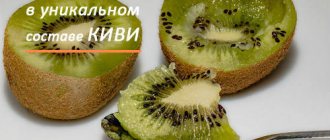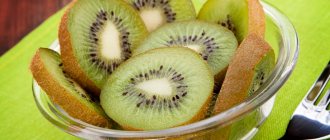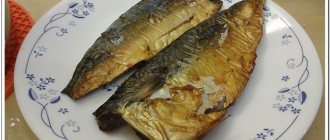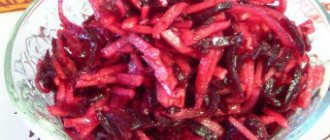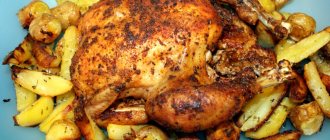Doctors recommend including kiwi in your diet - an exotic product with unique properties. The popularity of the overseas fruit is growing. In this regard, many people are beginning to wonder what the benefits and harms of kiwi are for the body.
Recently, the expression “the best dessert is fruit” has become increasingly popular. From a consumer point of view, it is quite justified: the fruits are indeed very sweet and juicy. But not only taste is important! If synthetic sweets are harmful to the body, then natural ones (grown on trees or bushes) give only benefits!
Chemical composition
The exotic berry, which market sellers persistently classify as a fruit, is grown in China and New Zealand. It’s not for nothing that kiwi is called “Chinese gooseberry”. As for the chemical composition, kiwi is superior in the content of some substances to bell pepper, lemon, black currant, etc.
100 g of green fruit pulp contains only 47 kcal. The table below will give you an idea of the benefits of kiwi.
| Item name | Contents per 100 g of product | Percentage of daily value, % |
| Proteins, g | 1,15 | 2 |
| Fats, g | 0,52 | 1 |
| Carbohydrates, g | 14,8 | 5 |
| Fiber, g | 3,9 | 19 |
| Organic acids, g | 2,6 | No data |
| Phytosterols, mg | 7,1 | 12,8 |
| Purine bases, mg | 11,0 | 8,3 |
| Vitamins, mg | ||
| Ascorbic acid | 90-180 | Up to 200 |
| Thiamine | 0, 03 | 1,8 |
| Riboflavin | 0, 032 | 1,5 |
| Pantothenic acid | 0,19 | 3,7 |
| Pyridoxine | 0,063 | 3,1 |
| Folic acid, mcg | 25 | 6,4 |
| Tocopherol | 1,5 | 9,8 |
| A nicotinic acid | 0,6 | 3,1 |
| Beta-carotene, mcg | 51 | 1,1 |
| Kholin | 7,9 | 1,7 |
| Macroelements, mg | ||
| Potassium | 330 | 12 |
| Calcium | 35 | 2,9 |
| Magnesium | 23 | 5 |
| Silicon | 20 | 58 |
| Sodium | 4 | 0,3 |
| Phosphorus | 35 | 4 |
| Microelements, mcg | ||
| Bor | 100 | 143 |
| Iron | 0,8 | 3,5 |
| Iodine | 2,2 | 1,4 |
| Copper | 135 | 13,5 |
| Aluminum | 820 | 2,3 |
Kiwi contains a large amount of antioxidants and serotonin. Therefore, this fruit (berry) is especially indicated for consumption by those who want to preserve youth and beauty for a long time, as well as get rid of insomnia and improve the quality of sleep.
Distinctive features
The first name of the fruit, Chinese gooseberry, was not assigned to kiwi. Although it was grown in northern China. Kiwi fruit first arrived in New Zealand in the early 20th century. The fruits of the plant began to be named after the bird that lives in this country, and which is considered its national symbol.
Where does this tropical fruit grow nowadays? Kiwi is grown on a large scale in Japan, the USA, Chile, as well as in France, Italy and Greece.
What type of plant does it belong to? For berries or fruits? In fact, kiwi is a berry that grows on exotic tree-like vines. The fruits come in two varieties: green and golden. Their flesh is usually yellow or green with small black seeds that are arranged in an oval pattern. The smell of kiwi is reminiscent of strawberries, and its unique taste is like a mixture of different fruits.
Beneficial properties for the body
In the absence of contraindications, doctors recommend introducing kiwi into your diet. The optimal quantity is no more than 3 pieces for adults and 2 for children. This berry is endowed with excellent taste characteristics and can bring real benefits to the body:
- Helps strengthen the heart muscle, as it contains large amounts of potassium, magnesium and ascorbic acid.
- Helps improve vision.
- Reduces blood pressure and has a beneficial effect on the walls of blood vessels, making them more elastic.
- Improves hair condition and prevents early greying.
- Positively affects digestive processes.
- Normalizes cholesterol levels.
- Suppresses the growth of cancer cells.
- Prevents the formation of kidney stones.
- Increases calcium absorption.
- Strengthens the immune system.
For diabetes
Kiwi contains sugar, which is extremely undesirable for consumption by people suffering from diabetes. But medical scientists agreed that kiwi is the healthiest fruit for diabetics. Because it contains a lot of fiber, which helps “regulate” blood glucose levels.
In the presence of glycemia, the patient has to keep under control the metabolic processes occurring in his body. If you ensure sufficient intake of vitamin C into the body, this will greatly contribute to the normalization of metabolism. Because kiwi is the absolute record holder for ascorbic acid content. The recommended dose for diabetics is 2-3 fruits per day.
A person whose body has impaired oxidative processes runs the risk of developing type 1 diabetes. To prevent this from happening, you should introduce kiwi into your daily diet.
When losing weight
- Has low calorie content.
- Has a low glycemic index (40).
- Contains the enzyme actinidin, which accelerates metabolism and promotes more complete absorption of protein.
- Participates in the process of fat breakdown.
- Effectively cleanses the intestines, as it contains a large amount of dietary fiber.
- Reduces appetite.
- Normalizes the functioning of the thyroid gland, which, among other things, produces hormones that are “responsible” for weight.
- Allows you to avoid a lack of vitamins while on a diet.
Popular diets
Classic . It has several variations (protein, low-carbohydrate, fruit). The diet can be anything, but it must include kiwi, in large quantities - up to 1 kg. The diet is classified as gentle, and its duration is 2 weeks. During this time, there is a chance of reducing your weight by 3-5 kg.
Mono-diet . This method of losing weight should only be used by people who do not have health problems. The essence of the diet is to eat 1-1.5 kg of kiwi daily. To prevent negative consequences, it is recommended to diversify the menu with boiled chicken breast (0.5 kg per day).
For slow and slight weight loss, you should eat 3 fruits every day.
For cholesterol
Studies on the topic “How kiwi affects cholesterol levels” have been conducted many times. They found that eating 2-3 pieces of kiwi every day reduces the content of fatty acids in the blood by about 15%. People who constantly eat green fruit pulp are less susceptible to atherosclerosis and other diseases of the cardiovascular system. The whole secret is in the unique chemical composition, which contains:
- the enzyme actinidin, which reduces the level of “bad” cholesterol in the blood (you can try a diet);
- ascorbic acid, which increases the production of lipase, an enzyme that breaks down triglycerides;
- vitamin B complex;
- potassium is a mineral vital to the heart.
To reduce cholesterol levels with the help of an exotic berry, you need to eat kiwi with the peel every day for three months: half an hour before each meal. At the same time, you should avoid eating foods containing large amounts of animal fats.
During pregnancy
Kiwi is good for pregnant women because it satisfies hunger and helps lift your mood. Moderate consumption of green pulp cannot harm the health of a pregnant woman or her unborn child. Recommended dose – 2 pcs. per day, in the absence of stomach problems and prohibitions from the gynecologist. You should eat kiwi during pregnancy because it contains:
- folic acid, which in the early stages of pregnancy eliminates the risk of improper development of the spinal cord rudiment;
- iron and ascorbic acid, responsible for the processes of hematopoiesis and metabolism;
- microelements and vitamins that a pregnant woman’s body urgently needs.
Contraindications
People with stomach problems (high acidity, peptic ulcer, gastritis) should avoid eating the fruit. Diseases of the excretory system may also be a contraindication, because kiwi contains a large amount of water and oxalates.
Individual intolerance is another contraindication. The fruit contains the enzyme actinidin, which is a strong allergen. You can identify the presence of allergies yourself.
Symptoms occur immediately after eating green pulp. This is inflammation and itching of the mucous membranes of the throat and oral cavity, nausea, “swelling” of the tongue, redness of the skin.
Kiwi in cosmetology
The berry, rich in vitamins and minerals, is beneficial for the body as a whole. But women who care about their own appearance should “adopt” kiwi. For example, if you grind the pulp of this fruit into a paste and apply it to your face with massage movements (for 15 minutes), you can make sure that it functions as a scrub. And very successfully, since the result of such scrubbing is noticeable from the first time.
Also, kiwi can be used as an ingredient in a hair growth mask. To prepare it, you will need half a kiwi and an “indefinite” amount of starch. Half a berry, peeled, must be thoroughly mashed with a fork. Mix starch into the resulting mass to make a paste. It is applied to the root zone, and the residue is evenly distributed along the entire length of the hair. To enhance the effect, it is recommended to wear a plastic cap and wrap your head with a towel. Exposure time is 40 minutes, after which you need to wash your hair with shampoo.
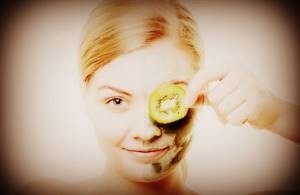
Face masks
- For problem skin and against acne. Apply the crushed pulp to your face, massage, wait 20 minutes and wash with cool water.
- Moisturizing. Mix 1 tbsp. l. chopped kiwi pulp and 1 tbsp. l. cottage cheese, add 0.5 tsp. olive oil. Apply the mixture to your face, wait 15 minutes and rinse with water at room temperature.
- Anti-aging. Grind 0.5 kiwi, mix with 1 tsp. honey. If after application you feel a tingling sensation, this means that the mask is “working.” It should be washed off 20 minutes after application.
To prepare masks, you need to use only ripe, but not overripe fruits. The finished mask can be stored for no more than an hour. You can't leave it on your face.
How to select and store
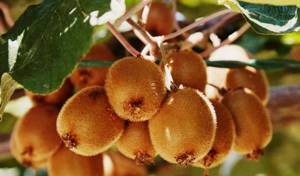
The overseas berry still causes mistrust among some people. But if the product is chosen correctly, then it can be eaten without fear. When purchasing, you should pay attention to the appearance of the fruit. The skin should have a uniform color, without spots, “wrinkling” and foreign inclusions (mold and rot).
In unripe kiwis, the “skin” has a greenish tint, it is not very thick and lacks a pronounced “fluffiness”. In the absence of external damage, the unripe fruit can ripen calmly at room temperature. To speed up the process, unripe kiwis should be placed in a paper bag along with a pear or banana.
When buying kiwi, it is recommended to press lightly on the surface. If the fruit is moderately elastic, but soft, then this means that it is ripe. Overripe berries are very soft, although for some consumers this is an advantage. A sharp sweetish smell indicates overripeness of the fruit, and an unobtrusive citrus aroma indicates ripeness and good quality. Storage conditions are standard - in the bottom drawer of the refrigerator.
If it is necessary to ensure the safety of the fruits for a longer period (7-10 days), then they should be stored in a tied plastic bag on the bottom shelf of the refrigerator.
Selection issues

Although the overseas fruit has already taken root in the country's markets, many people still look at it with some caution, because they do not know how to choose kiwi.
- By buying from street vendors, you run the risk of purchasing low-quality fruits that have been treated with chemicals or grown with pesticides.
- The ripe fruit will be slightly soft to the touch, but firm. Excessive softness indicates that the kiwi is overripe. And too hard fruit will be sour and unripe. Such products can be placed next to bananas or apples - speedy ripening is guaranteed.
- High-quality kiwi should not have a pronounced odor. Often fermented fruits smell like wine.
- Dark spots or a grayish coating on the peel are signs of disease, rot, or deterioration. Carefully inspect the fruit from all sides.
- A ripe, healthy berry should not release droplets of moisture.
- In the minds of the average person, kiwi is a fruit with a brownish skin covered with sparse fluff. However, a new variety has recently been developed, the peel of which has a pleasant green tint and a smooth texture. They say that this variety has a richer taste, but the “bald” fruits are much more expensive.
A fruit chosen according to all the rules will bring you and your family real pleasure.
Recipes with kiwi

Green smoothie with kiwi, celery and cucumber for weight loss
Kiwi smoothie
The drink is called “Emerald Cocktail”. To prepare it you will need:
- Kiwi (2-3 pcs.).
- Low-fat kefir – 150 g.
- Natural honey - 3 tsp.
The cooking process is simple. It is necessary to free the kiwi from the “hairy” skin, cut the pulp into cubes, combine with the rest of the ingredients and beat with a blender or mixer until smooth. Strawberries, bananas, and other berries and fruits can be added to the smoothie.
Fruit salad
Ingredients, pcs.:
- Kiwi – 2.
- Orange – 1.
- Apple – 1.
- Banana – 1.
- Pear – 1.
The fruits are peeled and cut into cubes. The filling function can be performed by fruit syrup or yogurt (in any quantity).
Vegan ice cream
To prepare this delicacy, which will be appreciated on a hot summer day, you will need:
- Half a glass of coconut milk.
- 3 kiwis.
- 1 avocado.
- 2 tbsp. l. maple syrup.
Peel and cut into cubes the avocado and 2 kiwis (the third berry will be needed for decoration). Place all ingredients in a blender bowl and puree until smooth. Place kiwi pulp, cut into circles, at the bottom of the ice cream molds. After this, the molds should be filled with the resulting mass and placed in the freezer for several hours.
Cooking time, which method is the fastest
In search of a quick way to peel kiwi, many have probably already tried an experiment using a timer. But whatever the method, it all depends on how well developed your hand is. It will be more difficult for a “student,” for example, to quickly cope with the process of peeling using a spoon than with a regular vegetable cutter. A comparison of these methods can be seen in the video on YouTube.
But we must give credit to the one who came up with the method with a glass, because both the juice and all the pulp remain in the glass, while the fruit has the correct shape for slicing. This method should also be trained for speed. The main thing is that you feel comfortable; the right choice depends on this.
